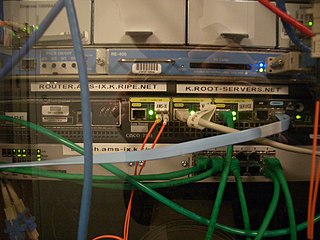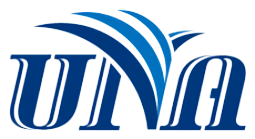The Domain Name System (DNS) is a hierarchical and distributed naming system for computers, services, and other resources in the Internet or other Internet Protocol (IP) networks. It associates various information with domain names assigned to each of the associated entities. Most prominently, it translates readily memorized domain names to the numerical IP addresses needed for locating and identifying computer services and devices with the underlying network protocols. The Domain Name System has been an essential component of the functionality of the Internet since 1985.

The Internet Corporation for Assigned Names and Numbers is an American multistakeholder group and nonprofit organization responsible for coordinating the maintenance and procedures of several databases related to the namespaces and numerical spaces of the Internet, ensuring the network's stable and secure operation. ICANN performs the actual technical maintenance work of the Central Internet Address pools and DNS root zone registries pursuant to the Internet Assigned Numbers Authority (IANA) function contract. The contract regarding the IANA stewardship functions between ICANN and the National Telecommunications and Information Administration (NTIA) of the United States Department of Commerce ended on October 1, 2016, formally transitioning the functions to the global multistakeholder community.
A top-level domain (TLD) is one of the domains at the highest level in the hierarchical Domain Name System of the Internet after the root domain. The top-level domain names are installed in the root zone of the name space. For all domains in lower levels, it is the last part of the domain name, that is, the last non empty label of a fully qualified domain name. For example, in the domain name www.example.com, the top-level domain is com. Responsibility for management of most top-level domains is delegated to specific organizations by the ICANN, an Internet multi-stakeholder community, which operates the Internet Assigned Numbers Authority (IANA), and is in charge of maintaining the DNS root zone.
A domain name is a string that identifies a realm of administrative autonomy, authority or control within the Internet. Domain names are often used to identify services provided through the Internet, such as websites, email services and more. As of 2017, 330.6 million domain names had been registered. Domain names are used in various networking contexts and for application-specific naming and addressing purposes. In general, a domain name identifies a network domain or an Internet Protocol (IP) resource, such as a personal computer used to access the Internet, or a server computer.
A domain name registry is a database of all domain names and the associated registrant information in the top level domains of the Domain Name System (DNS) of the Internet that enables third party entities to request administrative control of a domain name. Most registries operate on the top-level and second-level of the DNS.

A root name server is a name server for the root zone of the Domain Name System (DNS) of the Internet. It directly answers requests for records in the root zone and answers other requests by returning a list of the authoritative name servers for the appropriate top-level domain (TLD). The root name servers are a critical part of the Internet infrastructure because they are the first step in resolving human-readable host names into IP addresses that are used in communication between Internet hosts.
The DNS root zone is the top-level DNS zone in the hierarchical namespace of the Domain Name System (DNS) of the Internet.
AlterNIC was an unofficial, controversial Internet domain name registry that relied on an alternative DNS root. The primary purpose of the project was to challenge the monopoly of InterNIC, the official governing body for generic top-level domains (gTLDs) until the creation of the ICANN in 1998. AlterNIC offered second level domain registration in its own TLDs at lower prices than InterNIC. However, these domain names could only be resolved by name servers that were specifically configured to use the AlterNIC root zone. The project is now defunct; the domain name alternic.net is parked and no longer associated with AlterNIC.
A country code top-level domain (ccTLD) is an Internet top-level domain generally used or reserved for a country, sovereign state, or dependent territory identified with a country code. All ASCII ccTLD identifiers are two letters long, and all two-letter top-level domains are ccTLDs.

.an was the Internet country code top-level domain (ccTLD) for the former Netherlands Antilles. It was administered by the University of the Netherlands Antilles. The domain was phased out after the Netherlands Antilles were dissolved in 2010. As of November 2010 the .an domain remained live with over 800 domains registered under .an, including secondary levels. On 31 July 2015, use of the domain was discontinued.

.so is the internet country code top-level domain (ccTLD) for Somalia. After a long absence, the .so domain was officially relaunched on November 1, 2010, by .SO Registry, which is regulated by the nation's Ministry of Posts and Telecommunications. It was launched through various accredited registrars around the world.

A DNS zone is a specific portion of the DNS namespace in the Domain Name System (DNS), which is managed by a specific organization or administrator. A DNS zone is an administrative space that allows for more granular control of the DNS components, such as authoritative nameserver. The DNS is broken up into many different zones, which are distinctly managed areas in the DNS namespace. DNS zones are not necessarily physically separated from one another, however, a DNS zone can contain multiple subdomains and multiple zones can exist on the same server.
Distributed denial-of-service attacks on root nameservers are Internet events in which distributed denial-of-service attacks target one or more of the thirteen Domain Name System root nameserver clusters. The root nameservers are critical infrastructure components of the Internet, mapping domain names to IP addresses and other resource record (RR) data.

Open Root Server Network (ORSN) was a network of Domain Name System root nameservers for the Internet. ORSN DNS root zone information was kept in synchronization with the "official" Domain Name System root nameservers coordinated by ICANN. The networks were 100% compatible, though ORSN was operated independently. The ORSN servers were primarily placed in Europe. ORSN is also used by public name servers, providing Domain Name System access freely for everyone, without any limitation until the project closed in May 2019. ORSN was primarily started to reduce the over-dependence of Internet users on the United States and Department of Commerce/IANA/ICANN/VeriSign, limit the control over the Internet that this gives, while ensuring that domain names remain unambiguous. It also helps avoid the technical possibility of global "Internet shutdown" by one party. They also expect their network to make domain name resolutions faster for everyone.
This article presents a comparison of the features, platform support, and packaging of many independent implementations of Domain Name System (DNS) name server software.

.biz is a generic top-level domain (gTLD) in the Domain Name System of the Internet. It is intended for registration of domains to be used by businesses. The name is a phonetic spelling of the first syllable of business.
.ss is the designated country code top-level domain (ccTLD) for South Sudan in the Domain Name System of the Internet. It is derived from the ISO 3166-1 alpha-2 code for South Sudan, which is SS. According to CIO East Africa, the TLD was allocated on 10 August 2011 following the country's declaration of independence from Sudan. The TLD was registered on 31 August 2011, but not added to the DNS root zone and was thus not operational. It was approved at the ICANN Board meeting on 27 January 2019 and was added to the DNS root zone on 2 February 2019.
Namecoin is a cryptocurrency originally forked from bitcoin software. It uses proof-of-work algorithm. Like bitcoin, it is limited to 21 million.

OpenNIC is a user-owned and -controlled top-level Network Information Center that offers a non-national alternative to traditional top-level domain (TLD) registries such as ICANN. As of January 2017, OpenNIC recognizes and peers all existing ICANN TLDs, for compatibility reasons. However, OpenNIC has not yet evaluated and does not hold a formal position on future ICANN TLDs.







